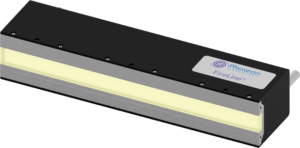An increasing number of printers are opting for LED curing technology regardless of the printing process. Here, Phoseon Technology looks at the opportunities to increase revenue with more press uptime, less maintenance and the ability to print on films and other heat-sensitive substrates.
Regulation is one of the main factors set to drive UV and LED curing technology forward. Legislative and non-governmental organisations worldwide continue to address concerns around products containing mercury, such as traditional arc lamps.
The European Union’s ‘Reduction of Hazardous Substances’ (RoHS II) places emphasis on finding suitable alternatives to mercury-containing devices, while the United Nations’ UNEP programme targets the removal of mercury. Many people in the industry predict the European Commission will begin limiting traditional lamp usage, starting first with smaller systems then working towards larger systems in ensuing years.
The return on investment can also be quite fast; users have reported saving more than
$20,000 per month after adopting LED curing technology.
“LED curing technology has been proven to be extremely reliable and customers can reap the benefits of the technology.”
KEEPING IT COOL
The output of a UV LED system is a narrow band of usable UV energy that does not emit infrared or harmful UV-C. Without emission in the infrared range, UV LED systems have the ability to print on heat-sensitive substrates that are not feasible with traditional arc lamps. Without the UV-C, there is no ozone creation, and therefore no need for air ducts or ventilation. Being a solid-state device, UV LED systems are instant on/off with no warm-up time. All of this results in savings of up to 70 per cent on electricity.
LED cooling is very important for UV light sources. UV LEDs transfer about 15-25 per cent of the received electrical energy into light. The remaining 75-85 per cent is transferred as heat, thus the need to cool the LED arrays. Currently, UV LED arrays are cooled with either air or liquid. It is important to note that as the LEDs emit higher output power, the more heat is generated. In the race to build ever-higher irradiance products, the ability of suppliers to control and remove heat has become more crucial to building reliable systems. As the quality of LEDs improves and the irradiance increases, so does the need to remove the heat. OEMs and end-users do not want to spend more on the LED cooling of the light sources.
With no IR heat, converters using UV LED technology can run thin and heat sensitive film, which adds new capability to the press. The amount of intensity to shrink film gives increased capability and more colour options. Metallic colours such as silver and gold have excellent depth and brilliance.
Examples of new capability generated from LED technology: Higher quality opaque whites and dense blacks with stronger depth cure; multiple thick layers cured all the way through with good inter-layer adhesion; expanded potential in cold foil adhesive offerings; UV adhesives, both for lamination and pressure sensitive adhesives; low migration/food packaging.
LED LIFETIME RELIABILITY
If architected correctly, LED light sources can have exceptionally long lives. Improved thermal management has helped to avoid overheating, and offer high quality UV output for a longer period of time. Similar to the lighting industry, LED curing technology has been proven to be extremely reliable and customers can reap the benefits of the technology.
Even though LED technology is reliable, it is important to keep in mind that LED light sources are not created equally. Suppliers have significant architectural and implementation decisions that impact their product’s performance. The end result will be a LED curing system with optimised LEDs, arrays, optics, and cooling for a specific application. Knowing how to characterise the performance allows the user to identify the best overall system to meet their needs.
Traditional mercury lamps may last up to 3,000 hours, but properly managed LEDs will last over 50,000 hours. With impressive efficiency and longevity, LED technology is poised to be an energy efficient technology. However, if the light sources are not cooled properly, they will have a much shorter lifetime and will be less reliable. Before choosing an LED supplier, ask them for data on the lifetime of their lamps to make sure they are proven to be reliable.
In 2015, Phoseon Technology announced that the lifetime testing of its lamps had surpassed 50,000 hours of operational ontime with lamp irradiance being greater than 80 per cent of its original output when the test first began over five years ago. For perspective, utilising a single shift workweek of 2,000 hours per year, 50,000 hours equates to 25 years of UV LED operating on-time.
Phoseon maintains over 50 UV LED curing lamps in various stages of lifetime testing at any given time. These light sources are stressed with decreased air flow, high temperatures and other parameters that mimic the harsh working conditions of industrial UV LED curing equipment.
The long lifetime of these products showcase Phoseon’s commitment to supplying high-performance, highly reliable light sources. The technology embedded in today’s UV LED lamps is built on this foundation so customers can be assured of many years of high-quality curing.
In addition to lifetime testing, Phoseon’s reliability programme consists of Highly Accelerated Lifetime Testing (HALT), Failure Modes and Effects Analysis (FMEA), and a manufacturing burn-in process where each product is built, calibrated, burned-in and recalibrated before customer delivery.
Tags: UV LED Curing for Printing Applications | UV LED Curing | Converter MagazineCategories: Printing, Flexo | Printing, Screen | Printing, Digital
